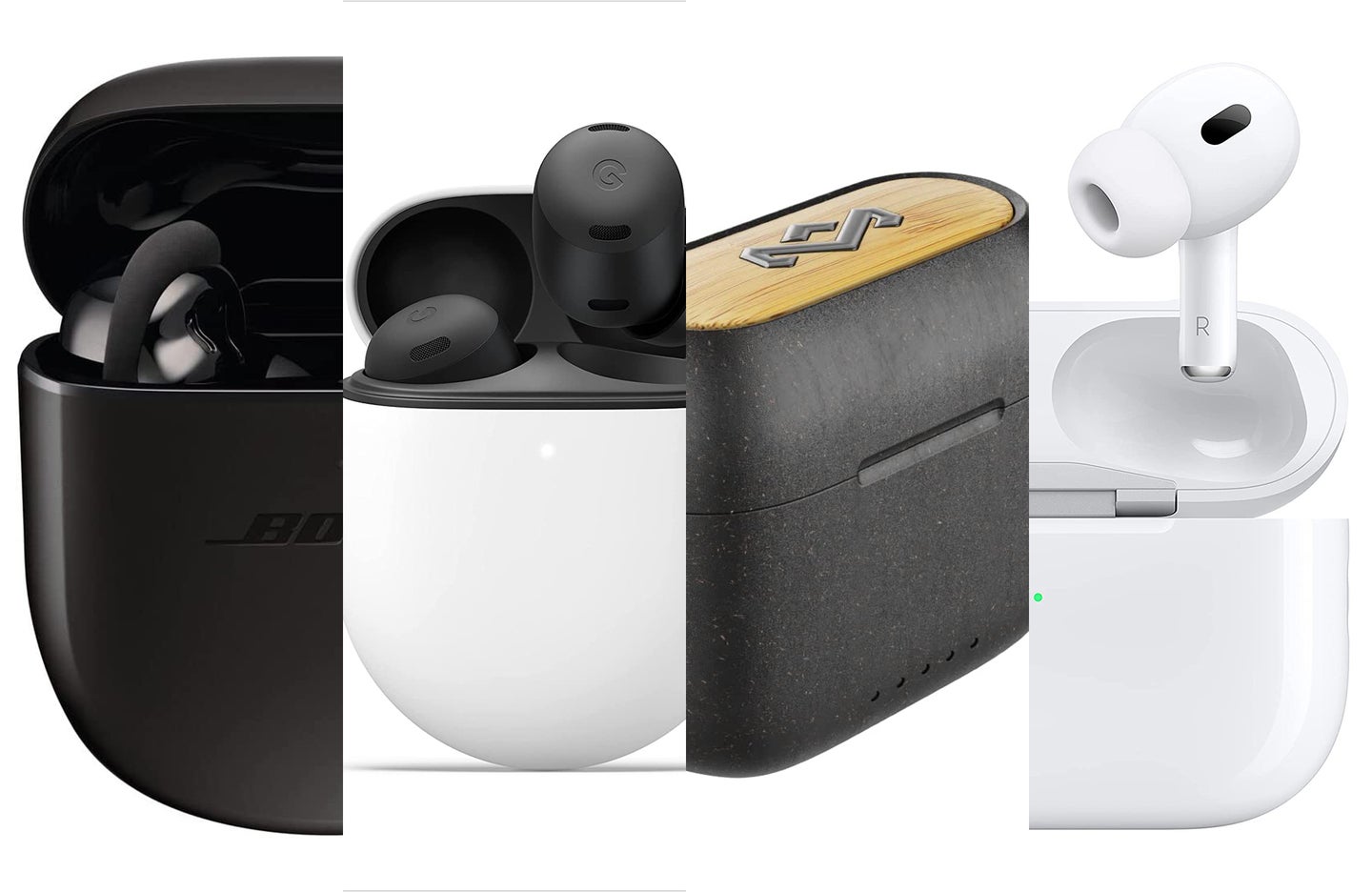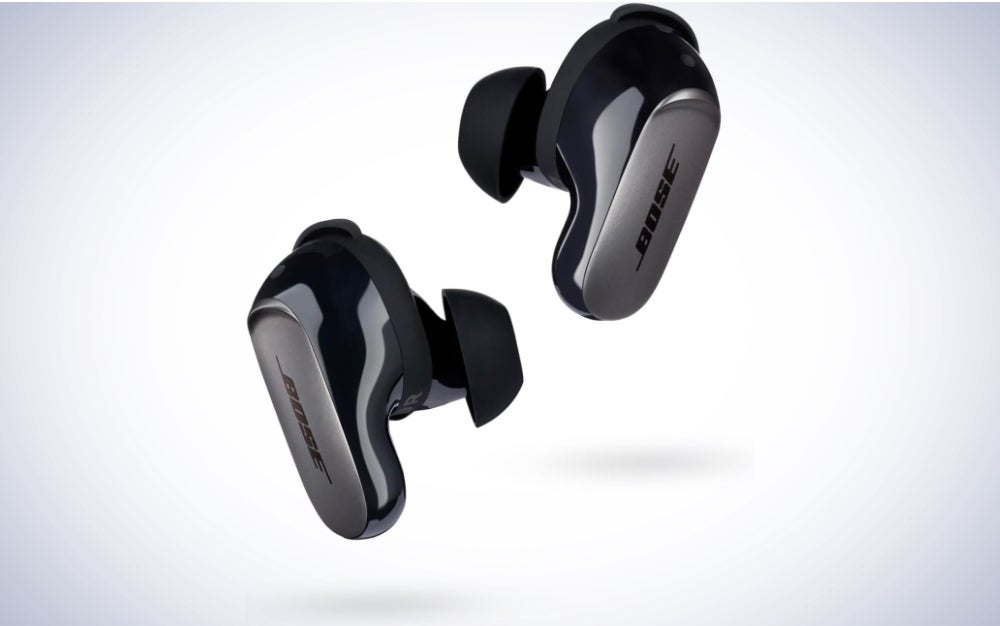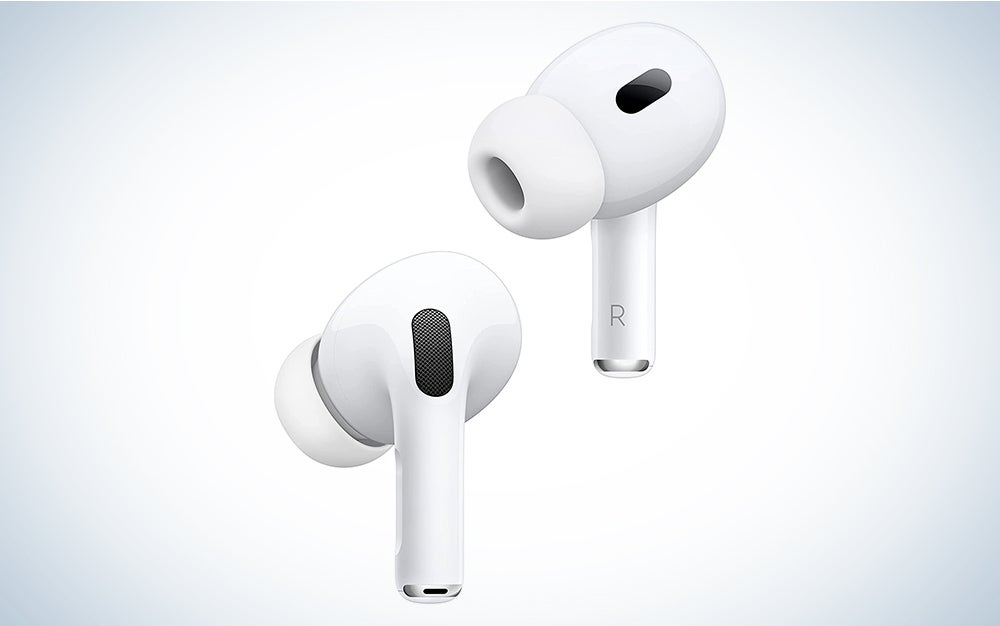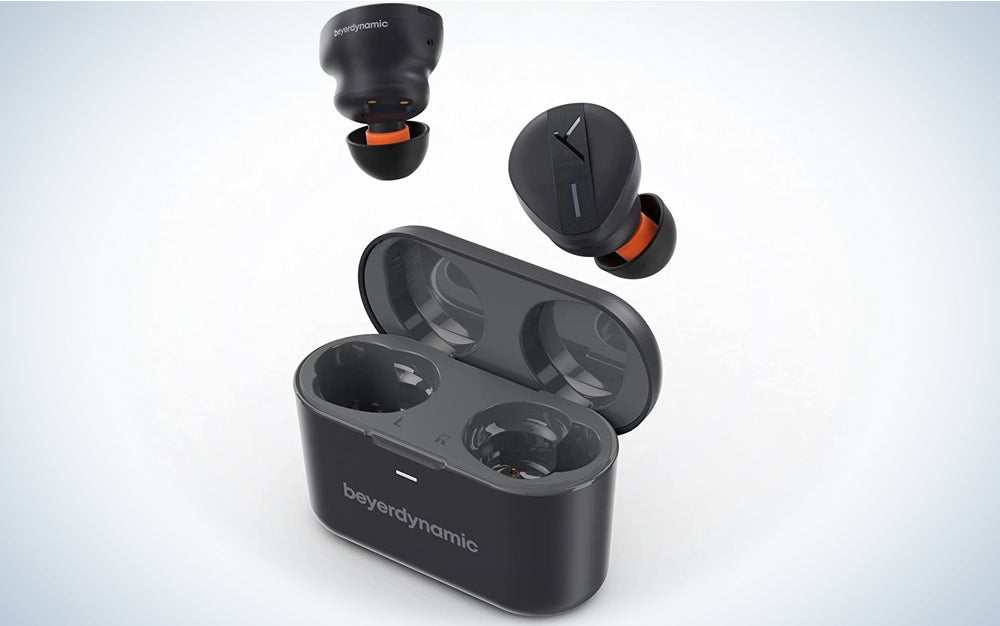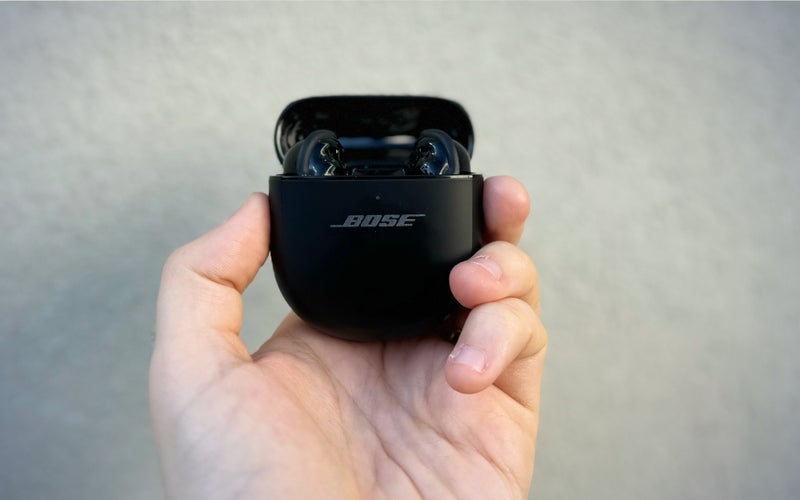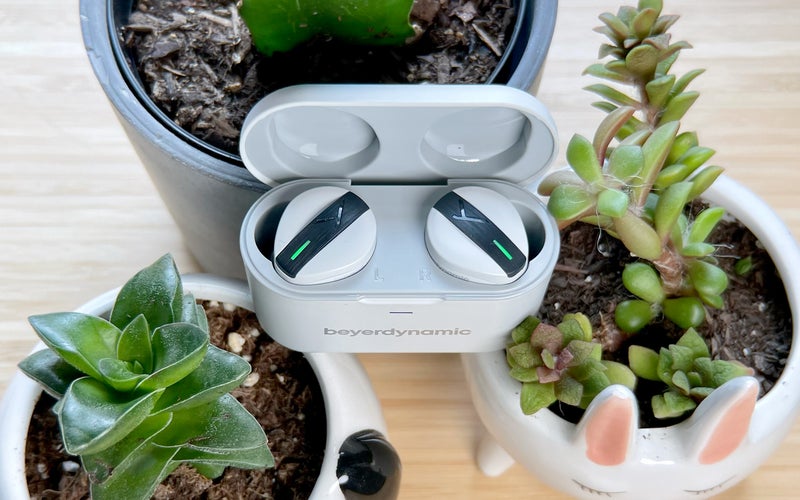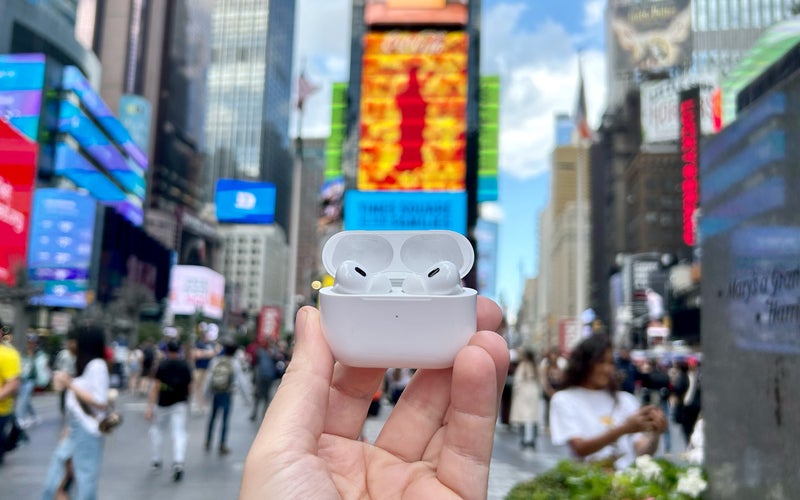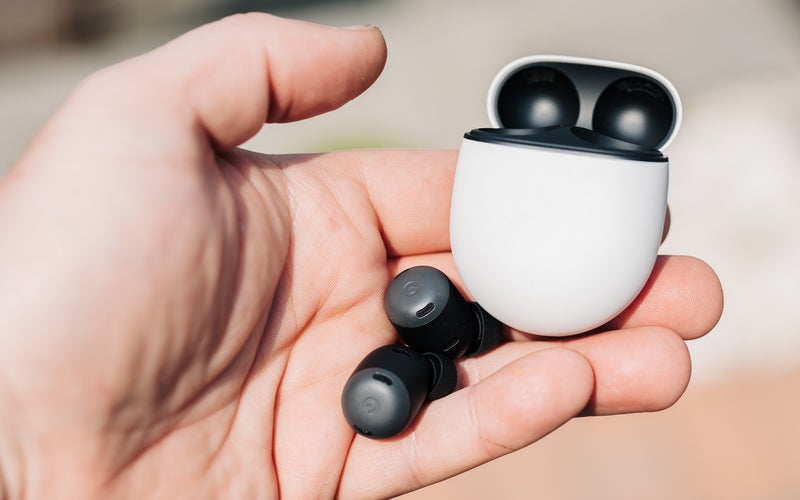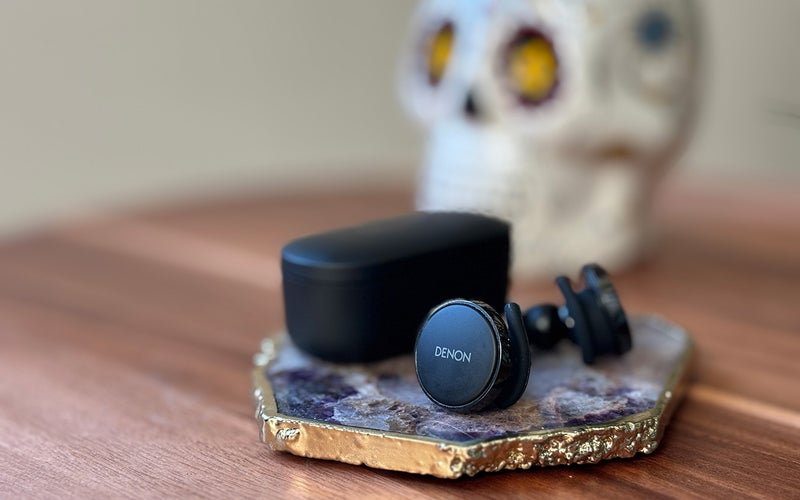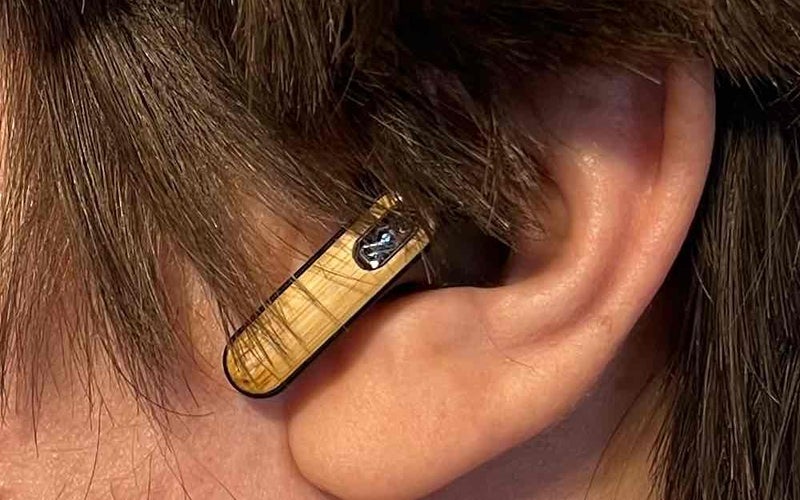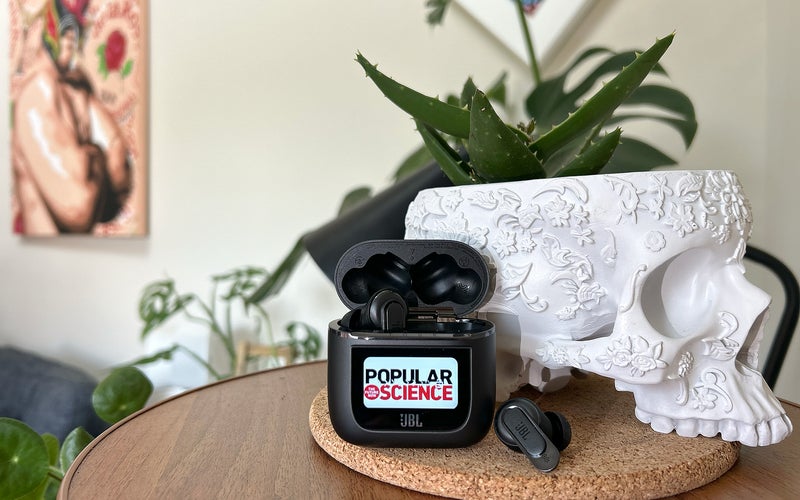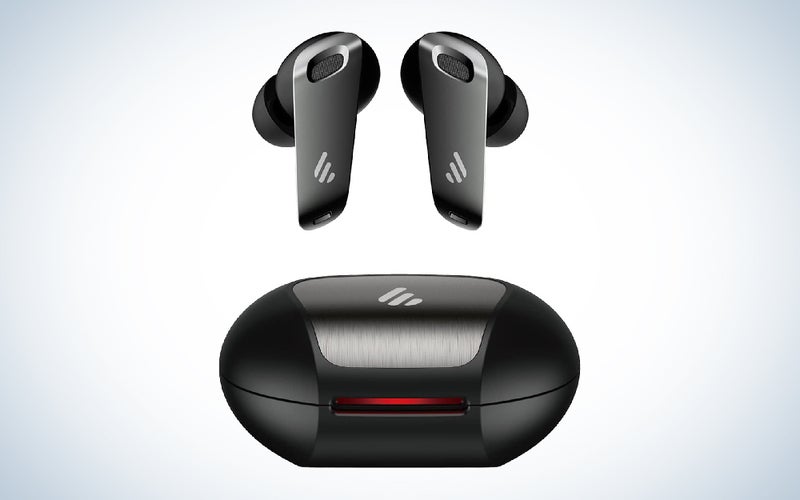We may earn revenue from the products available on this page and participate in affiliate programs. Learn more ›
The proliferation of noise-cancelling earbuds is one of the most impressive developments in the world of consumer audio—if not consumer electronics. The feature, which sucks up energy and requires both processing power and high-quality microphones, seemed at first like it’d be impossible to implement in gadgets that can fit in your pocket. Early noise-cancelling earbuds were wired, like their full-sized headphones counterparts, and came with a bulbous battery pack that needed to be charged frequently. However, as noise-cancellation technology (and rechargeable batteries) evolved, it came to over-ear wireless headphones, then on-ear wireless headphones, and finally earbuds. There are now plentiful earbuds with noise reduction as a standard feature, and they’re not all expensive. If you’ve enjoyed noise cancellation on over-ear headphones, but want the convenience of wearing earbuds, here are the best noise-cancelling earbuds to get.
- Best overall: Bose QuietComfort Ultra
- Best battery life: beyerdynamic Free BYRD
- Best for Apple users: AirPods Pro (2nd generation)
- Best for Android users: Google Pixel Buds Pro
- Best for custom sound: Denon PerL Pro
- Best for sustainability: House of Marley Redemption ANC 2
- Best case: JBL Tour Pro 2
- Best budget: Edifier NeoBuds Pro
What is noise cancellation?
Noise cancellation is a feature and phrase thrown around a lot, but it can mean a couple of different things. First off, there are two types of noise cancellation: passive and active.
All earbuds with properly fitted eartips provide passive noise cancellation, which happens when a ‘bud creates a tight seal within your ear canal. This physical barrier muffles noise from the outside world, whether your earbuds are turned on or off. Passive noise cancellation is the equivalent of hearing a loud noise in one part of your house and closing the door to the room you’re in.
Active noise cancellation is what most people think of when they hear the term “noise cancellation.” Active noise cancellation, or ANC, was initially introduced to provide clarity and relief for pilots and passengers to combat thunderous airplane engine noise. In 1989, Bose released the first commercially available active noise reduction headphones, aptly called the Aviation Headset. Since that noise-cancelling device, ANC-equipped personal audio gear has swept the market, letting users tune out everything from a roommate’s constant cooking to construction work next door to the coffee shop where you’re working remotely. But how does it work?
Earbuds with ANC have microphones that systematically capture outside noises within a certain frequency range. A chip inside each earbud analyzes the sounds you normally hear in real-time, then creates an inverse soundwave to counteract it. The better the microphones and algorithm, the more effective this feature is at reducing noise.
One of the main reasons active noise cancellation drains so much energy is that it’s running all the time. Sounds from the environment around you change every second, and the earbuds you’re wearing need to adapt on the fly. Oh, and all this is happening while you’re sending audio to the earbuds over Bluetooth, which they need to play. All of this technology is especially impressive with true wireless earbuds because each bud has to do this processing on its own while staying in sync with one another and your device.
The energy drain of active noise cancellation is one of the primary reasons earbud battery life doesn’t improve very much year over year. Gains in battery life through power efficiency or new hardware are immediately “spent” on processors that require more power for better active noise cancellation. Ultimately, the tradeoff is worth it as long as battery life doesn’t get much worse. Plus, you can always turn active noise cancellation off to conserve power in a quiet environment.
How we chose the best noise-cancelling earbuds
Our noise-cancelling earbud recommendations are based on hands-on testing and research. We considered peer recommendations, critical reviews, and user impressions, as well as the PopSci staff’s extensive first-hand experience in personal audio. Below are the factors we considered most highly when deciding which noise-cancelling earbuds to include in this buyer’s guide.
The best noise-cancelling earbuds: Reviews & Recommendations
With these factors in mind, we’ve assembled a list of noise-cancelling earbuds that perform well in every category but excel in one of them. Sometimes, we’ve offered alternatives within the same category to give you even more choices. The earbuds that’ll work best for you depend on your top priority—audio quality, longevity, durability—and budget. In this guide, you’ll find our flagship picks, with some affordable alternatives, but if you want to skip straight to sampling ANC for less, you can also check out the options in our best cheap wireless earbuds guide. We’re happy to see companies continue to push one another (and themselves) to get the highest performance levels into increasingly small form factors.
Best overall: Bose QuietComfort Ultra
Brandt Ranj / Popular Science
Why it made the cut: Bose’s QuietComfort Earbuds Ultra have the most-efficient noise cancellation of any earbuds we’ve ever tested—to an almost eerie extent.
Specs
- Battery Life: Six hours (24 hours with charging case)
- Weight: 4.54
- Price: $299.99
Pros
- Best-in-class noise cancellation
- Multiple microphones in each bud
- Spatial Audio support
Cons
- No multipoint pairing
The QuietComfort Ultra Earbuds build upon the solid foundation of last year’s QuietComfort Earbuds II and continue to be best-in-class. We described the noise-cancellation performance of Bose’s previous generation as “scary” due to the genuine sense of isolation we felt when testing them. We’re here to say that’s still the case, and the noise cancellation performance is even better. In quiet areas—think home or hybrid offices—the earbuds will completely block out common sounds like typing on a keyboard, walking around, and even opening doors with the music at a low volume.
Testing these earbuds on the New York City subway system was similarly revelatory. Listening to the Mamas & the Papas should not have resulted in missing an announcement that the train was going to be rerouted on a different line, and yet it did. It wasn’t that we were trying to ignore the subway conductor’s warning, it was that we weren’t even aware of it. The subway train’s squeaks and shuffles were still audible when music was off or we listened to spoken word content like podcasts, but music would consistently zero it out. It’s a downright odd sensation to feel a train moving and not being able to hear it.
This level of ANC performance comes courtesy of a multi-microphone array built into each bud. These mics also come in handy when taking or placing phone calls, as they blocked out a fair bit of common noise like wind that would have distracted our fellow caller. The Bose QuietComfort Ultra Earbuds’ noise cancellation is unparalleled, and enough to make us recommend them to frequent fliers and commuters on its own, but they also sound excellent.
We put these earbuds through their paces by listening to a wide range of music genres from different eras, from Taylor Swift’s new take on “1989,” to tracks from Bob Marley’s “Sounds of Freedom” through a compilation of the 1980s proto-Britpop band The Aardvarks. Some tracks were lossless (or high resolution) streamed from Apple Music and others were lossy AAC files from our personal library. Your experience will vary based on the mastering and recording of your favorite music, but we couldn’t find fault with the way the QuietComfort Ultras sounded.
The EQ choices Bose made when developing these earbuds were subtle ant tasteful, you won’t hear unnecessarily boomy bass or crispy treble. We found the earbuds were particularly good at reproducing the sounds of acoustic instruments from guitars in pop songs to string and brass sections in classical and jazz recordings. We had enough esteem for these earbuds that we chose to use them during our first listen of “Now and Then” the final Beatles recording ever made.
The latter was available with a Dolby Atmos mix, which allowed us to put these earbuds “immersive audio” setting to the test. Enabling this setting allows you to hear music as if it was being played through a pair of speakers, with audio shifting as you move your head. The effect is neat, and shows how much processing power the QuietComfort Ultras have under the hood, but we mostly listened to music in stereo. If you have a problem with the way these earbuds sound out of the box, you can tweak them to your liking by adjusting their EQ within the Bose Music app available on iOS and Android.
Our experience with these earbuds was almost universally positive, but we’re puzzled by their lack of multipoint pairing. You can only keep them connected to one device at a time, which is limiting and cumbersome if you want to go from listening to your music on your phone during a commute and on your computer at your desk. It’s a hiccup that’s especially surprising because these earbuds support Bluetooth 5.3 and Spatial Audio, two cutting-edge, resource-intensive features.
With that caveat aside, anyone who’s shopping for a pair of noise cancelling earbuds in 2023 should turn to Bose first.
Best battery life: beyerdynamic Free BYRD
Tony Ware
Why it made the cut: The beyerdynamic Free BYRD will likely outlast your desire to listen to music in a single sitting.
Specs
- Battery Life: Eight hours (31 hours with charging case)
- Weight: 7 grams
- Price: $299.99
Pros
- Exceptional battery life
- Comes with eight sets of ear tips
- Great fit
Cons
- Slight ear protrusion
German audio component manufacturer beyerdynamic has a rich history in the audio world (topping our mixing headphones list, among others). We were impressed by the overall performance of its Free BYRD noise-cancelling earbuds. Their marquee feature is battery life: The earbuds could run for up to eight hours with active noise cancellation turned on, and beyerdynamic says they’ll last a full 11 if you turn it off. With mixed use, you should expect to get around nine-and-a-half hours of playtime before popping the earbuds into their battery case, where they’ll offer up roughly an hour of music playback off a 10-minute charge.
Most of the active noise-cancelling earbuds we’re recommending last around six hours, and while the difference between six and eight may not seem like a lot, it’ll make a big difference on a transatlantic flight. Eight hours of battery life means you may never have to hear the full sound of a whirring plane engine ever again. The Free BYRDs’ battery life helps the active noise-cancelling earbuds stand out but it’s not the only reason they’ve made this list.
The earbuds have very good noise cancellation performance, and only fall short when directly compared to Bose’s QuietComfort Earbuds II. We weren’t completely isolated from the outside world when using the Free BYRD earbuds, but they blocked enough sound when listening to music at 80% that only very loud sounds could poke their way through the bubble. This is partly because beyerdynamic includes eight sets of ear tips with the earbuds—five silicone, three memory foam—so I found a set that fit my ears perfectly. The tight seal didn’t hurt my ears and the Free BYRDs never came loose, whether we were headbanging, running, or sitting still.
Regarding audio quality, the 10mm dynamic drivers in these guitar pick-esque earbuds were on-par with what we heard from the AirPods Pro 2 and Bose QuietComfort Earbuds II. Thanks to Bluetooth 5.2 (with SBC, AAC, aptX Adaptive codecs), there was enough rich detail across the 10Hz – 22 kHz frequency spectrum to fully enjoy any music we listened to and voices during spoken word audio—be it audiobooks, dialogue from TV shows, or podcasts sounded surprisingly natural. We liked how they sounded from the moment we first turned them on—balancing punchy bass, midrange clarity, and plenty of nimble transients—and didn’t feel the need to make any changes using the software EQ in beyerdynamic’s MIY app.
That app will run you through a hearing test to create a custom tuning based on how well you can hear specific frequencies, but we didn’t notice a huge difference before and after. Your mileage may vary based on the sensitivity of your ears, though, so it’s worth taking a couple of minutes to run through the test. Whether you choose to or not, we can’t imagine anyone being disappointed by how the Free BYRDs sound if you’re already aware of the auditory limitations of using active noise-cancelling earbuds.
What you should be aware of is the fact that the Free BYRDs will stick out of your ears a little more than your typical pair of wireless earbuds. It’s not that they’re especially prominent, but the feeling is noticeable. The upside is that this makes them easy to install and remove from your ears, but you may be more aware of them than other earbuds depending on the sensitivity of your ears. Beyond that, there’s much to like about beyerdynamic’s Free BYRD.
If battery life is important to you, Sony’s WF-1000XM4 earbuds are another great choice. The earbuds’ audio quality (supporting the hi-res LDAC and 360 Audio formats) and deep app-based customization options, eight-hour battery life, and active noise cancellation are superb. This is because Sony’s custom Integrated V1 processor is responsible for all three features, and you won’t find a similar pair anywhere else. These used to be the best noise-cancelling earbuds on the market before the Bose QuietComfort Earbuds II, and we can’t see anyone being disappointed by them.
If you want to shave off a little cost but are also willing to lose a little battery life, the company’s slightly newer LinkBuds S are also worth a look. The smaller earbuds inherit some of the WF-1000XM4s’ noise cancellation technology and dynamically change the intensity of that feature based on your environment. Plus, the earbuds have Alexa built-in, so you can control them using Amazon’s smart assistant if you prefer it over Google Assistant and Siri. All this while still managing a solid six hours of charge. Also worth noting is that both Sony models received multipoint compatibility via a firmware update.
Best for Apple users: AirPods Pro (2nd generation)
Tony Ware
Specs
- Battery Life: Six hours (30 hours with charging case)
- Weight: 5.3 grams
- Price: $249.99
Pros
- Upgraded noise cancellation and audio fidelity
- Expanded tip selection
- Find My feature
- Personalized Spatial Audio
Cons
- Worse experience on non-Apple devices
The second-generation AirPods Pro earbuds (colloquially known as AirPods Pro 2) are an improvement over their predecessor in every way. The jump in the earbuds’ active noise-cancelling ability was especially impressive in our tests. Apple says the AirPods Pro 2, while still only 5.4g each, are capable of blocking up to twice as much noise as the previous generation and, while that metric is difficult to quantify, we noticed the difference immediately.
We could fully block out the sound of a New York City subway car when listening to music at a volume level of 80%. However, a fair bit of noise was audible when we switched to a podcast. Meanwhile, listening to music at a volume of around 60% canceled out the sound of people walking and talking on a New York City street. Most of the sound from cars was eliminated, too, but we could hear horns when they were honked.
The AirPods Pro 2’s new low-distortion, high-excursion 11mm drivers are tuned to accentuate bass frequencies and sounded best when we listened to modern pop music. Classic rock and jazz tunes sounded good, too, but these earbuds were clearly designed to appeal to the average music listener rather than an audiophile. Apple doesn’t offer a digital EQ to tweak the AirPods Pro 2’s sound either. Still, more often than not, you’ll be pleased with what you hear when you hit the play button—especially when paired with one of the newest iOS devices via Bluetooth 5.3 with AAC.
You can pair the AirPods Pro 2 to any device, but connecting them to an Apple device puts the earbuds into a league of their own. Simply opening the case near an iPhone will allow you to pair the earbuds and will automatically add them to your list of Apple devices over iCloud. If you use an iPad or Mac, the AirPods Pro 2 will be paired to them automatically. Additionally, you’ll be able to use Apple’s Find My app to locate your earbuds if they get lost.
Find My and iCloud syncing are nice-to-have features, but Apple also locked the AirPods 2’s Personalized Spatial Audio inside of its walled garden. This iOS 16 feature allows you to improve the quality and realism of Spatial Audio—de-mixing Dolby Atmos tracks into earphone/headphone-friendly surround sound with head tracking—by scanning your face and ears with your iPhone’s selfie camera. The smartphone will use this imaging to update the Spatial Audio algorithm based on the shape and size of your head and ears. This feature takes about a minute to set up and is enabled automatically, though you can turn it off if you don’t hear a difference (we did, but mainly in spatialized stereo).
Apple updated the AirPods Pro 2’s case with a larger battery (it offers 30 hours of extra battery life instead of 24), has a speaker that chimes when it’s charging, and has a lanyard loop. The AirPods Pro 2’s case can also play a tone when you’re trying to find the earbuds using the Find My App, which makes them easier to locate. Apple made a bunch of meaningful updates to the AirPods Pro 2 over the previous generation, and it’s hard to imagine anyone creating a better pair of noise-cancelling earbuds to use with the company’s other gear.
Best for Android users: Google Pixel Buds Pro
Stan Horaczek
Why it made the cut: The Pixel Buds Pro takes advantage of Google’s most technically impressive services, whether you’re on an Android device or not.
Specs
- Battery Life: Six hours (30 hours with charging case)
- Weight: 6.2 grams
- Price: $249.99
Pros
- Multipoint pairing
- Realtime translation
- Excellent battery life
Cons
- Some features are locked into Google Services
It should come as no surprise that the best active noise-cancelling earbuds for Android users are made by—get ready for this—Google. The Pixel Buds Pro leverages some of the company’s most impressive services and marries them with sleek-looking hardware.
The Bluetooth earbuds are platform agnostic to some degree, meaning they work identically when paired to hardware running iOS, Android, macOS, Windows, or ChromeOS. Like the AirPods Pro 2, the Pixel Buds Pro supports multipoint pairing, which means you can connect them to two devices and hop between them at will. (If this feature is a top priority, the recently released Technics EAH-AZ80, featured in our best earbuds overall roundup, ups the ante with the ability to connect to and switch between three devices, plus the wireless sound quality is really good.)
An IR sensor will detect when the earbuds are in or out of your ears, and will start or pause audio automatically based on their state. Google says the earbuds will last up to 11 hours per charge without active noise cancellation enabled, or seven when you keep it on constantly. That’s still an hour longer than the AirPods Pro, which is impressive from a pair of earbuds that’s physically smaller.
On the audio hardware side, Google’s Pixel Buds Pro earbuds are powered by a custom-designed 11mm driver that supports an interesting feature called Volume EQ, which automatically adjusts the way the earbuds sound based on how loudly or softly you’re listening to music. The average listener may appreciate this auto-balancing feature, but audiophiles may shutter at the idea that their music will sound different at different audio levels. Thankfully, you can manually adjust a five-band software EQ if you’d prefer total control.
The Pixel Buds Pro also supports a raft of other typical-but-nice-to-have features found on many earbuds with active noise cancellation. Their case is IPX2 certified, which means it can be exposed to some water without being damaged, and it can be recharged on a wireless charger. The earbuds themselves are IPX4 certified, which means they’re sweatproof and can be exposed to a fair amount of water, like heavy rain. Touch-sensitive sensors on each earbud allow you to play or pause your music with a tap, change your songs with a swipe, or activate the Google Assistant with a long press.
Speaking of the Google Assistant, that’s the only smart assistant you’ll be able to use with the Pixel Buds Pro, which locks you into the search giants ecosystem. Additionally, some of the earbuds’ most technically-advanced features like real-time translation all happen through Google Translate. This level of lock-in isn’t as severe as Apple’s on the AirPods Pro, but it’s worth noting. If you’ve already bought into the Android ecosystem, that issue isn’t likely to bother you, in which case you should get the Pixel Buds Pro without reservation.
Another great option for certain Android users is Samsung’s Galaxy Buds2 Pro, which we reviewed earlier this year. The earbuds look, feel, and sound great, but have features that are only enabled when you pair them to a Samsung Galaxy phone. The list of features includes Smart Things Find, Spatial Audio, and 24-bit audio decoding courtesy of the SSC Hi-Fi audio codec. Samsung took a page out of Apple’s playbook this time, and it’s kept us from recommending the Galaxy Buds2 Pro to all Android owners. If you already use a Samsung Galaxy phone, though, they deserve your consideration.
Best for custom sound: Denon PerL Pro
Tony Ware
Specs
- Battery life: 8 hours
- Weight: 8.6g
- Price: $349
Pros
- Custom audio profiles make a big difference
- Support for the aptX Lossless codec
- Comfortable fit
Cons
- Price
Denon’s PerL Pros are among the most interesting earbuds we’ve ever tested because everyone’s experience will be a little different. That’s because their marquee feature is the ability to use Denon’s iOS or Android app to create a custom sound profile based on your hearing. The test consists of listening to a handful of tones for a couple of minutes. The earbuds analyze the hearing response for your ears and creates a custom profile. Denon recommends you conduct this test in a quiet environment, and our tests found that there was a difference in a profile created in a place with and without much noise.
You don’t have to use the PerL Pro’s custom profile—the app even allows you to toggle it on and off in a single tap, so you can hear the difference in real time—but you’ll get used to it very quickly. We had a pair of our team members test these earbuds using the stock earbuds EQ, their personalized profile, and the other reviewers personalized profile. The differences between each was immediately recognizable, and we encourage you to read our full review.
Explaining exactly how the PerL Pros sound can be difficult, but we will say that there was a tremendous amount of detail in the music we listened to regardless of the profile that was selected. We could easily hear background elements of songs that would’ve been either drowned out or muddy on lesser earbuds. Your personalized profile will accentuate different frequencies, which may clash with your favorite genres of music, but that wasn’t true for us. If you have the right source and streaming service, these earbuds are capable of playing back tracks encoded in the aptX Lossless codec, which narrows the gap between streaming and CD-quality listening.
The Denon PerL Pro’s active noise cancellation was more than respectable, blocking out footsteps and keyboard clicks with music at a low volume. Cranking it up near 100% would cancel out most of a New York Subway car’s clanging, though some of its loudest noises were still audible. One of the big reasons for the PerL Pro’s excellent ANC performance was their very tight (but comfortable) fit in our ears. Running and jumping couldn’t dislodge them, and the solid seal ensured excellent bass performance.
These earbuds are pricey, but the technology they employ guarantees you’ll hear music in a way that’s tailor-made for your ears. If you struggle with noticeable frequency loss or sensitivities, and don’t find mucking around with a digital EQ knob to be acceptable, pick up these buds.
Best for sustainability: House of Marley Redemption ANC 2
Brandt Ranj
Why it made the cut: House of Marley’s Redemption ANC 2s prove you can be a healthy, eco-conscious audiophile.
Specs
- Battery Life: Six hours (24 hours with charging case)
- Weight: N/A
- Price: $169.99
Pros
- Fantastic fit
- Sustainable materials
- Fast charging
Cons
- Lackluster app
Technology and sustainability are typically at odds with one another, but the House of Marley Redemption ANC 2s prove they’re not always mutually exclusive. The earbuds and their case are made, in part, out of solid bamboo, natural wood fiber composite, and recycled plastics.
In our experience choosing these materials didn’t hurt the performance of the Redemption ANC 2s, which compare favorably to our other active noise-cancelling earbud recommendations when you factor in their lower price. In addition, the earbuds actually beat our other recommendations in terms of durability thanks to their IPX5 durability rating, which means they’re waterproof enough not to be damaged by sweat, adding to their life-cycle and ours as they can be great for workouts. [Remember: If you choose to exercise in ANC earbuds, enable transparency mode during outdoor runs so you can stay aware of your surroundings.]
We were perfectly happy with the ANC 2’s namesake feature, which allowed the earbuds to block out a lot of noise when listening to music between 80% and 100%. The earbuds could completely eliminate softer sounds—keyboard typing, feet tapping, walking around a home—but louder sounds like car horns could still be heard pretty prominently. Commuters and air travelers will certainly notice a dip in the sound of their train and plane noises, but you’ll still sense that they’re there.
Similarly, the Redemption ANC 2s sound very good, but audio sounds “veiled” when compared directly to beyerdynamic’s Free BYRD, Apple’s AirPods Pro 2, and Bose’s QuietComfort Earbuds II. We couldn’t hear the same level of detail, and the music sounded slightly flatter overall. Some frequency ranges, bass especially, fared better, but we could definitely hear a little more muddiness when listening to very vocal-heavy music. There was also a bit of sibilance and a slight tendency for high frequencies to sound a little too sharp.
None of this detracted severely from our enjoyment of the music, but the $80 difference between this pair of active noise-cancelling earbuds and a premium pair was certainly noticeable. You can adjust the EQ of these earbuds using House of Marley’s app but the software is extremely barebones. House of Marley’s app is a letdown considering how good the hardware is.
The Redemption ANC 2s may not be able to stand toe to toe with premium earbuds in the audio and noise cancellation areas, but they have the edge over some when it comes to battery performance. The earbuds get up to six hours of music listening per charge, support wireless charging, and offer two hours of music playback off a 15-minute charge. Similarly, the earbuds are IPX5 certified, which means they can stand up to water better than more expensive pairs.
If you care deeply about the sustainability of your technology, House of Marley’s ANC 2s are the best active noise-cancelling earbuds available right now. They’re also a solid set of earbuds if you’re trying to keep your budget under $200.
Best case: JBL Tour Pro 2
Tony Ware
Why it made the cut: JBL’s Tour Pro 2 is a case study in offering easier, phone-free access to settings.
Specs
- Battery Life: 8 Hours
- Weight: N/A
- Price: $249.99
Pros
- Touchscreen case
- Six-microphone array
- Smart ambiance detects sounds and adjusts ANC
Cons
- Price versus the competition
JBL’s Tour Pro 2 are unlike any ANC earbuds we’ve tried. JBL didn’t invent a new shape, battery technology, or audio codec—instead, the company focused on designing an all-new smart charging case. The Tour Pro 2’s case—available in both black and champagne—has a colorful 1.45-inch LED touchscreen on it, which is as bonkers as it sounds. By swiping across the display, you can access up to 14 settings panels without touching your phone.
The touchscreen’s functionality is surprisingly robust, which makes it feel like more of a feature than a gimmick. You can use the case for basic functions like changing your music volume or switching and pausing a track, but the features don’t stop there. Within a couple of swipes and taps you can adjust the earbuds’ ANC/Ambient Aware/TalkThru settings, change their EQ, set a playback timer, or change the spatial sound settings. You can even receive phone notifications, like a basic smartwatch (don’t expect Apple Watch-level integration, but it’s something). Basically, if you can do something inside the JBL Headphones app (iOS and Android), the Tour Pro 2’s case gives you the same options. You can even change the screensaver, so you don’t have to use our logo like in the image above (though you could).
JBL took a cue from smartphone makers and designed the case to go to sleep after 30 seconds. Once it wakes up, you have to swipe across its screen to unlock and access your settings, eliminating the chance of accidentally changing a setting while grabbing the case in your pocket. It feels odd to take some much time talking about the Tour Pro 2’s case, but it’s the standout feature of these earbuds.
Inside the case, you’ll find a pair of sleek but relatively standard-looking stemmed true wireless earbuds with a comfortable fit. They’re IPX5, ready for sweat as you rush through public transportation (the case, however, should avoid a splash). Our limited tests so far have produced positive results—the Tour Pro 2’s adaptive ANC blocked a fair amount of noise when riding on a New York City subway train and walking on its busiest streets, even without the volume cranked up. Rumble fared a bit better than chatter, but the attenuation was solid across the board. The earbuds last a fair amount of time per charge—8 hours with ANC on, with up to 30 more in the case, and I can keep track of both battery levels by checking the screen, naturally. This is great for travelers or commuters who don’t want to plug their buds in to charge every night. On that note, the Tour Pro 2’s case supports wireless charging, which is another nice plus. And it has a “Find My Buds” feature that triggers a high-pitched tone, perfect for finding that rogue earbud that fell in the couch.
As for the sound, first impressions are of a crowd-pleasing V-shaped signature, with energetic boosted bass and slightly goosed highs. JBL is a Harman company, and this is the Harman curve (a target that tries to represent the lively sound of speakers in a room). There aren’t the rich midrange details of the Sennheiser MOMENTUM True Wireless 3 or the nimble dynamics of the AirPods Pro 2, but the 10mm dynamic drivers do a great job of conveying all the thump, if not every texture. To my ears, things sound tighter with an iPhone using the AAC codec than on an Android using SBC (the Bluetooth 5.3 Multipoint earbuds will get LE Audio’s Auracast/LC3 codec support in a future firmware for more high-resolution playback). If you want to customize the response, there are five sonic presets (Jazz, Vocal, Bass, Club, Studio), and you can draw and save your own curve with the 10-band EQ. If that feels too involved, take the Personi-Fi hearing test, which will generate a custom profile for you (according to our associate managing editor, who tried it first, the test resulted in less low-end and more highs, which he thinks tracks with the ears of an old former DJ).
If you’d like to try a pair of true wireless earbuds that feel futuristic or don’t want to take your phone out of your pocket each time you need to fumble with a setting or change a song, JBL’s Tour Pro 2 earbuds are well worth checking out. We hope that JBL introduces even more functionality through software updates since this technology feels like it has so much potential.
Best budget: Edifier NeoBuds Pro
Edifier
Why it made the cut: Edifier’s NeoBuds Pros have no right to have as many features as they do for earbuds so close to $100.
Specs
- Battery Life: 6 Hours
- Weight: N/A
- Price: $99.99
Pros
- Easily accessible sound modes
- Six microphone array
- Fast charging
- LDAC/LHDC hi-res codec support
Cons
- Only comes with three sets of eartips
Edifier’s NeoBuds Pro TWS earbuds may not seem impressive at first glance, but that quickly changes when you realize the noise-cancelling earbuds cost only $100. Name a feature, and the NeoBuds Pro checks the box: active noise cancellation, long battery life, fast charging, hi-res codecs with compatible devices, multiple (adjustable) EQ modes, solid water and dust resistance, in-ear detection, touch-sensitive buds. And, on top of that, great sound from the hybrid driver design combining a high-sensitivity Knowles balanced armature for precise highs with a composite diaphragm dynamic driver for impactful mids and lows. It’s hard to find meaningful features these budget earphones don’t have.
We won’t say the Edifier NeoBuds Pro will be able to compete with the Bose QuietComfort Earbuds II in a head-to-head competition of audio and active noise cancellation performance. Still, you’d be hard-pressed to find a better pair in this price range. We’re especially impressed by the earbuds’ six-microphone array, which will come in handy for noise cancellation and when taking phone calls.
Most noise-cancelling earbuds have multiple pre-set sound modes, but Edifier made the wise design choice to map them to the touch-sensitive surface of the left earbud. Tapping on it twice will enable “Normal Mode” while tapping three times will cycle through game mode and spatial audio. It’s helpful to have these settings at your fingertips (literally) rather than having to fumble through an app on your phone.
The NeoBuds Pro earbuds have the same battery life and fast charging speeds as House of Marley’s ANC 2s, which is even more impressive given their extremely low price. With five hours ANC on (plus 15 hours from the case) or six hours ANC off (and 18 hours from the case), you should be able to get through a trans-continental flight without having to top them up. Similarly, the earbuds have an IP54 durability rating, so water and dust shouldn’t impact them too much, whether heading into work or working out.
The world of budget audio has expanded enough over the past few years that we can easily recommend earbuds under $100 for casual listeners. We’d prefer Edifiers to include more than three sizes of ear tips with the earbuds to ensure you’ll get a perfect fit, but that’s the only surface-level indication that these noise-cancelling earbuds are designed for people on a stricter budget.
Another pair of budget-friendly noise-cancelling earbuds you should consider is 1More’s AERO, which supports spatial audio and head tracking. The AEROs have 12 preset EQs that you can switch between, and the earbuds can dynamically adjust their noise cancellation based on your environment. The earbuds typically cost $109.99, but Amazon is currently offering a $20 off coupon that takes them under $90.

Another brand that’s really packing in the features for commuters and travelers who don’t want to hear the noise of a train car or airplane but find over-ear headphones cumbersome to pack, much less snooze with, is EarFun. There might not be a buzzword mentioned throughout this piece that isn’t found in the EarFun Air Pro 3 Bluetooth 5.3 earbuds. From aptX Adaptive to Hybrid ANC, multipoint to six Environmental Noise Cancellation (ENC) microphones, an app with customizable EQ to wireless charging, these stemmed AirPods alternatives factor it all in for under $80. If your budget is very tight, EarFun’s Air S earbuds offer multipoint pairing, aptX support, and a fully customizable EQ for under $70. The Air S earbuds’ six-hour battery life isn’t too shabby, either.
The popularity of ANC has really given audio companies a reason to continually improve the efficiency of their hardware and pursue improvements in digital signal processing and power efficiency. EarFun is definitely a brand that’s really maximizing technological miniaturization.
Things to consider before buying noise-cancelling earbuds
All of the earbuds we’re recommending in this guide are wireless because wired earbuds with active noise cancellation are cumbersome to use. Additionally, many devices—phones and tablets especially—don’t have a headphone jack anymore, so you’d need to carry around an adapter to use this type of tethered processor.
True wireless
There are many types of noise-cancelling earbuds, but we’ve focused exclusively on “true wireless” pairs. This is because most companies are putting their cutting-edge active noise cancellation technology into this type of earbud, so you end up with the best performance.
The term “true wireless” means that each earbud connects to your device independently, without a cable tethering them together. Early true wireless earbuds suffered from connectivity problems—with devices and between the buds themselves—but that has changed thanks to improvements in the Bluetooth wireless protocols. Now there are all kinds of higher efficiency, higher bitrate codecs (including aptX HD/Adaptive and LDAC) that allow TWS earbuds to take advantage of advanced-resolution formats from audiophile sources, such as the best DAPs (digital audio players). The popularity of true wireless earbuds is such that they’ve also come down in price quite a bit. You’ll pay more for a pair of true wireless earbuds that support active noise cancellation than one without, but you can get away with spending less than $150 and still having a good experience.
Battery life
We discussed the reality of earbud battery life earlier, but we’re pleased to say that newer pairs last a lot longer than those released just a couple of years ago. You should expect to get at least six hours of playtime from all of the noise-cancelling earbuds we’re recommending—though this will depend on how loudly you listen to your music. If you use active noise cancellation judiciously, you can likely get a couple of additional hours out of them.
One of the upsides to using a pair of true wireless earbuds is that it comes with a battery case. Your earbuds will be charged any time you’re not using them—so long as you remember to plug the case in every once in a while (most accept USB-C cables, while some charge wirelessly). This accessory will keep your noise-cancelling earbuds safe when you’re not using them, and extend their life by at least 16 hours or so.
Gummy eartips
Silicone- and/or foam-tipped earbuds are required for active noise cancellation because they create a tight seal within the ear that insulates your ear canal from the environment and lets all the ANC counterwaves work their magic. In addition, a proper seal is required to experience quality bass response. If you’ve traditionally struggled to keep this style of earbuds in your ear, don’t worry. All of the noise-cancelling earbuds we’re recommending come with multiple sizes of ear tips, and we strongly recommend trying each set out to find the one that fits you best (and the number of third-party ear tips available on Amazon is staggering if you’re looking to emphasize a particular feel or frequency response). If your earbud’s ear tip comes loose, it won’t be able to cancel noise or play audio efficiently.
Microphones
Microphones are essential for active noise cancellation to work on earbuds—or any style of headphones for that matter. Every pair of earbuds in our guide has at least one microphone on each bud.
Multipoint pairing
Originally a luxury feature, but finding its way into more and more earbuds, multipoint enables your noise-cancelling wireless earbuds to stay connected to multiple devices simultaneously. This allows you to switch from playing music on a smartphone to your computer for a conference call without dealing with settings panels and (re)pairing connections. Maintaining simultaneous connections with multiple devices is tricky, so earbuds with this feature can still be hit or miss.
FAQs
Q: How much do noise-cancelling earbuds cost?
The price of noise-cancelling earbuds varies based on their battery life, audio hardware, and other performance characteristics, but our recommendations range in price from just under $100 to hovering around $300.
Q: Are noise-cancelling earbuds worth it?
Yes, we believe that noise-cancelling earbuds are undoubtedly worth it. The ability to silence a loud train car, chatty coworkers, next-door construction, and practically any whirring can elevate any listening experience. You’ll be able to focus on the task at hand or calmly zone out at any time. Most noise-cancelling earbuds also let you adjust the cancelation level or turn it off completely, so you get the best of both worlds. If you typically wear earbuds anyway, you should have a pair that supports this feature.
Q: Can noise-canceling earbuds damage hearing?
No. While some people can experience a sense of pressure when using noise cancellation, it’s not harmful or damaging. If anything, noise-cancelling earbuds can actually help your hearing by allowing you to listen to audio at lower volume levels. You won’t have to crank up your music, audiobook, or podcast to compete with the volume level of your music, audiobook, or podcast to block unwanted sounds happening around you.
Q: Are earbuds or headphones better for noise cancellation?
While earbuds are certainly equipped with excellent noise-cancelling technology, headphones add another layer of isolation because they cover the ear’s reflective surface, passively blocking out even more noise, plus have larger drivers so they can produce both more music and more noise-cancelling waves. However, if you’re looking for something super portable, comfortable for a workout, or discreet, noise-cancelling earbuds will certainly be better than headphones.
Q: Is it bad to sleep with noise-cancelling earbuds?
While we’re not doctors, it’s well-documented that certain noise-cancelling headphones or earbuds can actually aid sleep (there are some even designed for the purpose). If you’re a light sleeper, easily disturbed by sound, noise-cancelling earbuds can help you drift off faster, stay asleep longer, and stave off nighttime anxiety around sleep. If you find snug, comfortable ear tips that allow the earbuds to fit cozily in your ears, you should have no problems sleeping with them.
Q: Do AirPods have noise-cancelling?
While AirPods Pro and AirPods Pro 2 support active noise cancellation, non-Pro AirPods do not have this feature.
Final thoughts on the best noise-cancelling earbuds
- Best overall: Bose QuietComfort Ultra
- Best battery life: beyerdynamic Free BYRD
- Best for Apple users: AirPods Pro (2nd generation)
- Best for Android users: Google Pixel Buds Pro
- Best for custom sound: Denon PerL Pro
- Best for sustainability: House of Marley Redemption ANC 2
- Best case: JBL Tour Pro 2
- Best budget: Edifier NeoBuds Pro
If you love music but live in a loud environment, noise-cancelling earbuds are your best audio investment. They’ll last an entire workday and can block the sounds of keys typing, toes tapping, and people around you talking. If you work from home but want to get out of the house, noise-cancelling earbuds can eliminate the sound of clinking cups at a cafe or people walking around in a park. It almost goes without saying that frequent travelers should consider the best noise-cancelling earbuds necessary.
Why trust us
Popular Science started writing about technology more than 150 years ago. There was no such thing as “gadget writing” when we published our first issue in 1872, but if there was, our mission to demystify the world of innovation for everyday readers means we would have been all over it. Here in the present, PopSci is fully committed to helping readers navigate the increasingly intimidating array of devices on the market right now.
Our writers and editors have combined decades of experience covering and reviewing consumer electronics. We each have our own obsessive specialties—from high-end audio to video games to cameras and beyond—but when we’re reviewing devices outside of our immediate wheelhouses, we do our best to seek out trustworthy voices and opinions to help guide people to the very best recommendations. We know we don’t know everything, but we’re excited to live through the analysis paralysis that internet shopping can spur so readers don’t have to.
